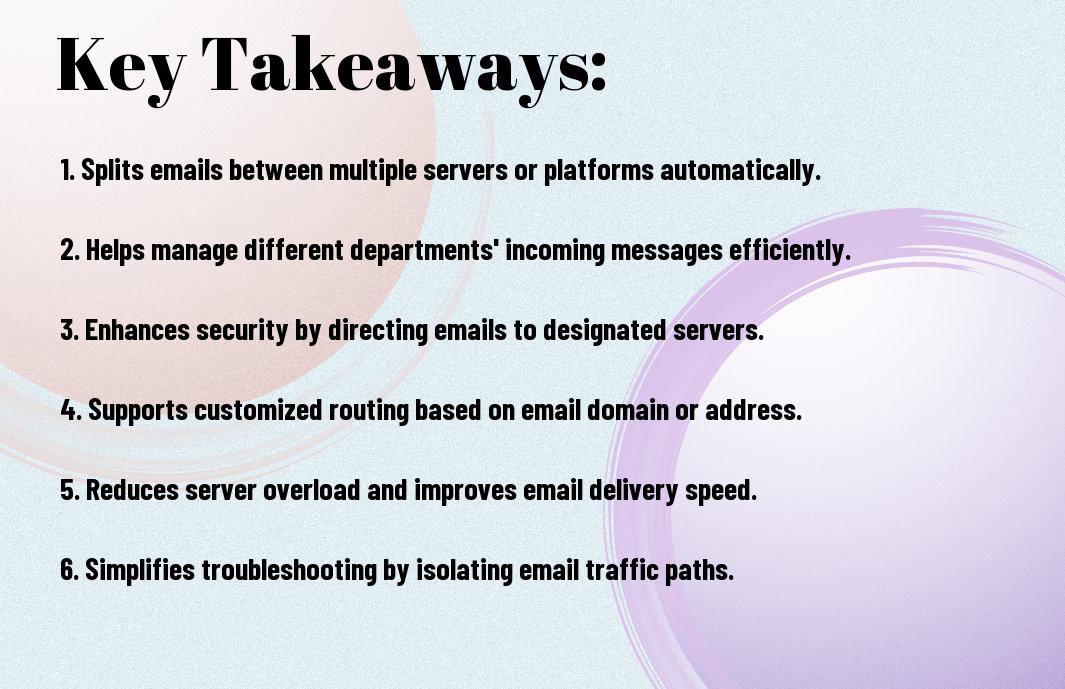There’s a practical strategy called split email routing that can significantly enhance your email management and operational efficiency. If you’re a business owner, understanding how this method works will help you streamline your communication processes and ensure that your emails reach the right teams without unnecessary delays. In this post, you will learn what split email routing is, how it functions, and the benefits it offers to your organization, allowing you to make more informed decisions about your email infrastructure.

Key Takeaways:
- Split email routing allows businesses to direct incoming emails to different servers or systems based on specific criteria.
- This approach can enhance email management by improving deliverability and minimizing server overload.
- Employing split email routing can help ensure compliance with data protection regulations by directing sensitive information to secure servers.
- Proper configuration and testing are imperative to avoid disruptions in email flow and ensure all emails are processed accurately.
- Integrating split email routing with existing communication tools can streamline workflows and improve overall efficiency.
The Mechanics of Split Email Routing
Understanding the mechanics of split email routing can demystify how your emails are efficiently managed and directed to the right recipients. In a typical setup, inbound emails are evaluated by routing algorithms that determine the optimal path based on criteria such as sender domain, recipient location, and load balancing. This ensures that resources are utilized effectively while improving response times, making communication smoother and faster for your business.
How Split Routing Works in Digital Communication
Split routing functions by filtering incoming emails through a set of defined rules and algorithms, directing them to various servers or mailboxes. As emails arrive, they are analyzed for specific parameters, ensuring the right team or department receives the message. This not only enhances organization but can also provide metrics on communication patterns and response rates across your organization.
Key Technologies Driving Split Email Systems
Split email systems leverage various technologies, including advanced email servers, automated routing algorithms, and integrated communication tools. These systems utilize protocols like SMTP (Simple Mail Transfer Protocol) and APIs (Application Programming Interfaces) to facilitate seamless communication between disparate platforms. Additionally, cloud-based solutions enhance scalability and ensure higher uptime, allowing your business to maintain robust email communication even during peak hours or technical disruptions.
Numerous software solutions play a significant role in the efficacy of split routing systems. For example, platforms like Microsoft Exchange or Google Workspace come equipped with built-in routing features that adapt based on user behavior and organizational needs. These tools can analyze email traffic patterns, allowing intelligent routing decisions that not only optimize system performance but also enhance user experience. Automated processes minimize human error, increase accuracy in delivery, and can even improve response times, which are critical metrics for customer-facing teams. The combination of these technologies transforms how your business engages with clients and partners, paving the way for more streamlined communication.


Maximizing Efficiency: Advantages for Businesses
Harnessing the power of split email routing opens up a range of efficiency benefits for your business. By intelligently dividing email traffic across multiple servers and channels, you can optimize both delivery speed and overall performance. This method ensures that your communications are not just timely but also reliable, ultimately enhancing customer satisfaction and retention rates. Organizations that implement split routing have seen up to a 30% increase in email deliverability, making it a smart choice for businesses aiming to streamline their communication processes.
Enhanced Email Delivery Rates
With split email routing, your business can enjoy significantly improved email delivery rates. By distributing your email load strategically, messages bypass common bottlenecks and network traffic, reaching recipients’ inboxes more quickly and efficiently. Studies show that businesses utilizing split routing witness fewer instances of emails being marked as spam, ensuring important communications land where they should.
Improved Security Measures and Redundancy
Employing split email routing enhances your security framework by providing multiple layers of safeguarding against data breaches. By isolating email flows through varied pathways, you mitigate the risk of a single point of failure, which can often lead to devastating security vulnerabilities. A multi-server approach allows for real-time monitoring across different channels, enabling you to detect and respond to threats more swiftly. In fact, businesses leveraging this method have reported a 40% decrease in phishing attacks, thanks to the multifaceted defenses provided by split routing practices.
Potential Pitfalls: Challenges and Solutions
While split email routing can significantly enhance your business operations, it isn’t without challenges. Misconfigurations can result in lost messages, delayed responses, or even increased security vulnerabilities. Identifying these potential pitfalls early and implementing effective strategies can safeguard your email system, ensuring smooth communication and minimizing disruptions to your workflow.
Common Misconfigurations That Lead to Issues
Misconfigurations often stem from incorrect DNS settings or failure to update routing rules. For instance, if MX records point to outdated servers, emails can get lost in transit. Additionally, not properly segmenting email traffic can overwhelm certain paths, leading to delays and bottlenecks. You should regularly audit configurations to prevent these mishaps.
Strategies for Seamless Implementation and Maintenance
Establishing a comprehensive maintenance schedule is vital for seamless implementation. Regularly review your routing configurations, ensuring they align with changes in your business operations. Implement monitoring tools to track email performance and identify issues proactively. Furthermore, training your team on how to operate within the split routing system promotes better overall functionality and minimizes human error.
To further enhance your email routing strategy, consider creating an ongoing feedback loop within your team. Encouraging employees to report any discrepancies or issues allows you to tackle problems before they escalate, ensuring a smoother communication path. Utilizing analytics from your email service can provide insights into routing efficiency, helping you make informed decisions that adapt to business growth or shifts in your needs. By addressing both technology and team awareness, you establish a robust email routing framework that stands the test of time.
Future Trends: The Evolution of Email Routing
The transformation of email routing is continuously evolving, driven by advancements in technology and the need for greater efficiency. Emerging trends indicate a shift towards more sophisticated routing solutions that leverage artificial intelligence and cloud computing, helping businesses optimize their email management strategies. As the volume of email communications grows, adopting innovative approaches will become imperative in ensuring seamless and secure transmission of information across networks.
Artificial Intelligence and Automation in Email Management
AI and automation are set to revolutionize email management, enabling more efficient routing systems that adapt based on user behavior and preferences. This technology can analyze patterns in email traffic, predict the most effective routing paths, and automatically prioritize messages, ensuring that critical communications reach their destination promptly without manual intervention.
The Role of Cloud Computing in Advanced Routing Solutions
Cloud computing plays a vital role in advancing email routing solutions by providing scalable infrastructure and real-time access to data. This allows for enhanced flexibility in managing email flow, with businesses able to integrate various routing protocols and access advanced analytics tools. Consequently, your email system can function optimally, reducing downtime and ensuring that messages are routed to the correct endpoints efficiently.
- Scalability of email routing systems.
- Real-time data access for better decision-making.
- Integration with existing cloud solutions.
- Cost efficiency by reducing hardware dependencies.
| Advantage | Description |
| Cost Efficiency | Reduces the need for expensive hardware by utilizing cloud resources. |
| Flexibility | Enables dynamic adjustments to meet changing email volume demands. |
| Integration | Seamlessly connects with other cloud-based applications for enhanced functionality. |
| Analytics | Provides insights into email traffic patterns, helping optimize routing efforts. |
Cloud computing enables your email routing systems to expand and adapt, facilitating a more sophisticated approach to email management. You can take advantage of scalable solutions that can handle fluctuations in email volume without compromising performance. Furthermore, integrating cloud-based analytics allows for deeper insights into user behavior, leading to improved decision-making and an overall more efficient email process that aligns with your business goals.
Summing up
As a reminder, understanding split email routing is vital for optimizing your email management strategies. By implementing this technique, you can ensure that your email traffic is effectively directed to the right servers, enhancing performance and security. For further insights, you can explore more details on what email routing is. This knowledge will empower you to make informed decisions that benefit your business operations.
FAQ
Q: What is Split Email Routing?
A: Split Email Routing is a method that allows businesses to direct incoming emails to different servers or services based on specific criteria. This can include factors such as the sender’s domain, the recipient’s address, or even content within the email itself. By implementing split email routing, businesses can efficiently manage their email flow, ensuring that emails reach the appropriate parties or systems without unnecessary delays.
Q: How can Split Email Routing benefit my business?
A: Implementing split email routing offers several benefits, including improved email security, better load handling, and enhanced organization. By directing sensitive emails to a secure server, for instance, you can reduce the risk of data breaches. Additionally, this method allows for better management of high volumes of emails by distributing the load across different servers, preventing any single system from becoming overwhelmed.
Q: What criteria can be used to route emails in Split Email Routing?
A: There are various criteria that can be employed for email routing in a split email routing system. Common criteria include the sender’s email address or domain, specific keywords in the subject line or body of the email, the size of the email, or even time-based rules (e.g., emails received outside normal working hours). These customizable options allow businesses to tailor their email routing to fit their operational needs and workflow.
Q: Is Split Email Routing complicated to implement for my business?
A: The implementation of split email routing can be straightforward, especially with the right software or email service provider. Many modern email systems offer built-in functionalities for routing emails based on various parameters. It’s imperative to evaluate your business’s specific requirements and select the tools that best align with your goals. Staff training and clear documentation can also simplify the process, ensuring everyone understands how the system operates.
Q: What should I consider when setting up Split Email Routing?
A: When setting up split email routing, consider factors such as the volume of emails your business receives, your existing infrastructure, security requirements, and desired organizational outcomes. It’s also beneficial to monitor the performance and efficiency of the routing rules you establish. This way, you can continually adjust and optimize the system to better serve your business’s needs as they evolve.

